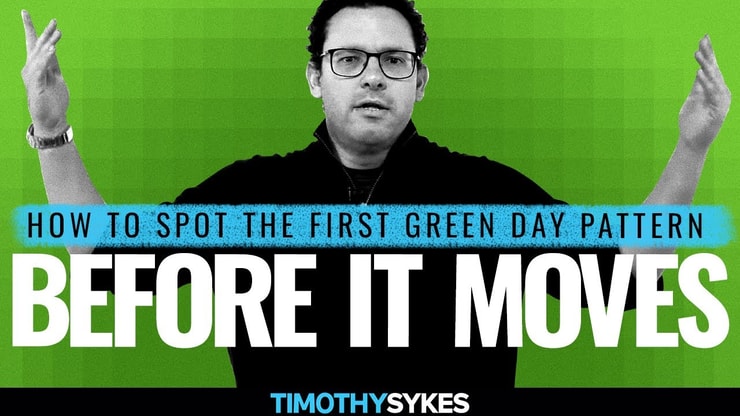The inverse cup and handle pattern is a bearish reversal pattern. It happens at the end of a bullish trend and signals lower prices ahead.
I don’t advise new traders to short stocks. Short selling is inherently more dangerous than long positions.
But we need to know short-seller patterns so that we know which stocks to stay out of.
Everyone that starts trading wants to make money.
But they learn pretty quickly, trading is more about ‘not losing money’. We want to stay out of bad trades.
Any fool can get lucky and make money in the market …
But it doesn’t matter because they’ll probably give it all away on the next trade.
Make sure you read this article on inverse cup and handles so that you have a clearer view of the market.
When we see things clearly, we can make more informed decisions. And that leads us to the most profitable setups.
Table of Contents
- 1 What Is an Inverse Cup and Handle?
- 2 Understanding the Structure of the Inverse Cup and Handle Pattern
- 3 How to Identify an Inverse Cup and Handle Pattern
- 4 How to Trade the Inverse Cup and Handle
- 5 Examples of Inverse Cup and Handle Patterns
- 6 The Reliability of an Inverse Cup and Handle Pattern
- 7 Limitations of the Inverse Cup and Handle Pattern
- 8 Key Takeaways
- 9 Frequently Asked Questions
- 9.1 Can an Inverse Cup and Handle Fail?
- 9.2 How Accurate Is an Inverse Cup and Handle Pattern?
- 9.3 What Is the Opposite of an Inverse Cup and Handle Pattern?
- 9.4 What Is the Inverse Cup and Handle, and How Does It Relate to the Channel in Technical Analysis?
- 9.5 Can I Find Content on Your Website That Provides Investment Advice on How To Trade the Inverse Cup and Handle Pattern?
- 9.6 What’s the Significance of the 50% Level in the Inverse Cup and Handle Pattern, and Can a Person Without Prior Knowledge Use It in Addition to Other Strategies?
What Is an Inverse Cup and Handle?

The inverse cup and handle is a price chart pattern indicating a downtrend. It’s the opposite of a bullish cup and handle, signaling potential declines in price.
Charts and analysis tools help identify this pattern. It’s essential for traders looking to profit from drops in the market.
Understand it, don’t fear it. It’s a chance to add another weapon to your trading arsenal.
The pattern consists of two parts: the “inverse cup” and the “handle.” You’ll spot it at the end of an uptrend as a warning of reversal.
Tools like moving averages and divergence indicators play their part here. But remember, no pattern guarantees success. Knowing the basics and applying them effectively is key.
Understanding the Structure of the Inverse Cup and Handle Pattern
When it comes to trading stocks, one of the fascinating chart patterns you’ll encounter is the inverse cup and handle.
Unlike the usual cup pattern, which signals an uptrend, this formation predicts a downtrend.
Picture it: the shape resembles a teacup, turned upside down.
In the beginning, you’ll notice the ‘cup’ — a rounded bottom formation. Half of the pattern is the ‘handle’ — a small correction before the breakout.
Some might confuse this with other patterns like the wedge or flag, but discerning traders will see the distinct peaks and the neckline. The pattern is crucial information in stock analysis and should be included in your arsenal of tools.
For another solid trade pattern, watch the video below …
Also, understanding the relative volume in trading is essential, especially when dealing with patterns like the inverse cup and handle. Relative volume helps in identifying the strength of trends and can be a crucial factor in determining the success of a trade.
It’s not just about recognizing the pattern; it’s about understanding the market dynamics that accompany it. If you want to delve deeper into how relative volume can enhance your trading strategies, you may find this guide on Understanding Relative Volume in Trading beneficial.
How the Inverse Cup and Handle Are Formed
The formation of the inverse cup and handle is a tale of market pressures and price trends.
Highs and lows play a game, forming the pattern’s shape. Volume, support, and resistance levels all have their roles. When the price chart paints this picture, seasoned traders take notice.
Understanding the Cup in Inverse Cup and Handle Pattern
The “cup” in this pattern is like a round top, with the highs forming the brim and the lows the base.
Price movements and trends are at the core, with tools like moving averages providing insight.
Analyzing volume and trading positions at this stage is crucial. They say the devil’s in the details. Well, your profits might be too.
Understanding the Handle in Inverse Cup and Handle Pattern
The “handle” is a small consolidation or retracement before a breakdown. It’s like the fuse before the explosion, a tug-of-war between buyers and sellers.
The resistance level here is critical, as are your decisions as a trader. Your platform, brokers, account management — everything is part of this equation. Take note of the handle; it’s where things get real.
How to Identify an Inverse Cup and Handle Pattern

In the realm of stocks, prices move in mysterious ways, yet there are signals for those who know how to read them.
The inverse cup and handle pattern is one such signal, indicating a possible downward direction. Unlike a continuation pattern, this is seen as a reversal.
How do you spot it? Look at the trading volume, the support level, and the support line.
Analyze the size, distance, and height of the formation, from the head down to the shoulders. Check for the breakout and breakouts, watch the risks, and be mindful of the stop-loss orders.
I show all my students how to analyze charts for popular patterns. I’ve even shared with them my most successful patterns and the ones I use over and over again.
All of this information is in the Challenge. It’s why all my millionaire students were once Challenge students.
>> This is the path they followed to success <<
And speaking of guidelines …
Identification Guidelines for Inverse Cup and Handle
To identify this pattern, you’ll need more than luck. Market analysis, price action, trendlines, and even your Nasdaq tools come into play.
Understanding the cup’s depth and the handle’s length is essential. This isn’t about guessing; it’s method and precision.
List of Things to Note in the Inverse Cup and Handle Pattern
The list of things to consider is like the roadmap to success. Volume, support and resistance levels, price trend, and even timeframe have a part to play.
One wrong move and your profits might slip away. It’s not about fear; it’s about control. Your education, books, courses, and experience are your tools here. Use them.
How to Trade the Inverse Cup and Handle

Now, knowing the pattern is one thing; trading it is another lot entirely.
The inverse cup and handle pattern isn’t just a decorative title on a chart; it’s a strategic tool for traders.
First, observe the stocks and the stock prices. Notice the formation, from the head to the handles. Understand the support level and the correction that leads to the breakout. Measure the distance from the neckline to the peaks and set your stop loss accordingly.
Investors and traders looking to play this pattern must know the timeframes suitable for their strategies. Performance must be monitored, and all data and information must be considered.
Interested in diving deeper? Trading courses are available to get you the results you seek. But remember, there’s no one-size-fits-all strategy here, and any trade must be pursued with caution. Note the disclaimer: not all cups of opportunity are filled to the brim, and careful handling is advised.
Trading the inverse cup and handle pattern requires a comprehensive understanding of various day trading indicators.
These indicators can guide you in making informed decisions, from entry points to setting stop-loss orders. Whether you’re trading stocks, forex, or futures, knowing how to utilize these indicators is key to your success.
If you’re interested in enhancing your trading skills with the right indicators, explore this detailed guide on Day Trading Indicators Explained.
Again, the inverse cup and handle pattern is a short-seller strategy. I’d feel more comfortable if you tried a pattern like the first green day. I included a video below …
Trading Strategies for Inverse Cup and Handle
Trading the inverse cup and handle is not about secrets; it’s about strategies.
Knowing your entry and exit points, using stop-loss orders, and setting a profit target are fundamentals. From forex to futures, the rules might differ, but the game is the same.
Entry and Exit Points in Inverse Cup and Handle Trading
Finding the right entry point in this pattern is as vital as your exit strategy.
Price breaks and pullbacks guide your way, and indicators like moving averages are your allies. Your risk tolerance dictates your moves, not gut feeling or pressure.
Setting Inverse Cup and Handle Price Target
Setting a price target in this pattern isn’t guesswork; it’s calculation.
Analyzing price charts, understanding support and resistance, and even considering market momentum — it’s all in the mix.
Like a seasoned chef, you know your ingredients. This is the recipe for trading success.
Risk Management in Inverse Cup and Handle Trading
Risk management isn’t just a term; it’s your shield. From understanding retracements to setting stop-loss orders, it’s the difference between profit and loss.
Strategies aren’t just options; they’re necessities. This isn’t a game; it’s your future.
Risk management is a vital aspect of trading, especially when dealing with complex patterns like the inverse cup and handle.
Utilizing tools like the VWAP (Volume Weighted Average Price) indicator can provide valuable insights into market trends and help in managing risks effectively. It’s not just about identifying the pattern; it’s about making calculated decisions that align with your risk tolerance.
To learn more about how the VWAP indicator can be a part of your risk management strategy, check out this guide on Understanding the VWAP Indicator.
Examples of Inverse Cup and Handle Patterns

You don’t have to take my word for it; examples of this pattern are all over the markets.
They’re in the charts, in the reviews, and in the success stories of traders who know their game.
Tools like divergence, resistance level analysis, and volume insights all play their part here. Your education isn’t complete without understanding real-world applications.
The Reliability of an Inverse Cup and Handle Pattern
Is the inverse cup and handle reliable? Well, no chart pattern is 100% foolproof. Cases and examples might vary, but the basics remain the same.
Your strategies, your brokers, your platform — they’re as vital as the pattern itself. No guarantees here, just opportunities. Trade smart, not hard.
Limitations of the Inverse Cup and Handle Pattern
Even the best tools have limitations. The inverse cup and handle is no exception.
Price movements, trends, even the best indicators have their shortcomings. Understand them; don’t ignore them. That’s the mark of a successful trader.
There’s no place for overconfidence here. Trading is about balance, judgment, and, above all, understanding.
Key Takeaways

Trading the inverse cup and handle is not about tricks; it’s about skills.
From understanding the pattern’s formation to trading it successfully, every step is vital. Tools, strategies, even your choice of brokers and platforms are part of this journey.
Stay sharp, stay focused, and remember: small gains add up.
Trading isn’t rocket science. It’s a skill you build and work on like any other. Trading has changed my life, and I think this way of life should be open to more people…
I’ve built my Trading Challenge to pass on the things I had to learn for myself. It’s the kind of community that I wish I had when I was starting.
We don’t accept everyone. If you’re up for the challenge — I want to hear from you.
Apply to the Trading Challenge here.
Trading is a battlefield. The more knowledge you have, the better prepared you’ll be.
Have you seen a cup and handle pattern in the market? Do you use it to trade? Let me know in the comments — I love hearing from my readers!
Frequently Asked Questions
Can an Inverse Cup and Handle Fail?
Yes, like all chart patterns, the inverse cup and handle can fail.
Markets are unpredictable, and things can change. Your strategies, your tools, your decisions – they all count. Learn from failure; don’t fear it.
How Accurate Is an Inverse Cup and Handle Pattern?
Accuracy in trading isn’t about perfection; it’s about probability. The inverse cup and handle offers cues, not certainties.
Your analysis, your tools, your methods — they shape your success. Understand them, master them.
What Is the Opposite of an Inverse Cup and Handle Pattern?
The opposite of the inverse cup and handle is the regular cup and handle, indicating an uptrend.
It’s another tool in your trading toolkit. From price trends to volume analysis, the game changes but the rules remain. Know them, use them, succeed with them.
What Is the Inverse Cup and Handle, and How Does It Relate to the Channel in Technical Analysis?
The inverse cup and handle is a bearish chart pattern used to predict potential downtrends in the market.
The pattern often forms within a descending channel, which acts as a confirmation for traders. The channel helps in defining the boundary of the pattern, with the support line at the bottom and the resistance line at the top.
Can I Find Content on Your Website That Provides Investment Advice on How To Trade the Inverse Cup and Handle Pattern?
Yes, we offer extensive content on the inverse cup and handle pattern, including trading advice, strategies, confirmation techniques, and more.
Our expert analysis can guide you in understanding when to enter or exit a trade based on this pattern, whether you’re a beginner or an experienced trader.
What’s the Significance of the 50% Level in the Inverse Cup and Handle Pattern, and Can a Person Without Prior Knowledge Use It in Addition to Other Strategies?
The 50% level often refers to a critical retracement point within the pattern, which can be a confirmation signal for the trend continuation.
Even a person with minimal experience can utilize this level in addition to other strategies by following proper guidelines and trading advice available on our platform.





Leave a reply